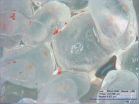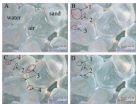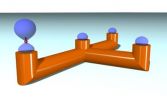(Press-News.org) VIDEO:
This video visualizes the effects of hydrofracking flowback fluid on colloid mobilization in unsaturated sand. Included are the injection of the colloids into the sand column at the beginning of...
Click here for more information.
ITHACA, N.Y. – The chemical makeup of wastewater generated by "hydrofracking" could cause the release of tiny particles in soils that often strongly bind heavy metals and pollutants, exacerbating the environmental risks during accidental spills, Cornell University researchers have found.
Previous research has shown 10 to 40 percent of the water and chemical solution mixture injected at high pressure into deep rock strata, surges back to the surface during well development. Scientists at the College of Agriculture and Life Sciences studying the environmental impacts of this "flowback fluid" found that the same properties that make it so effective at extracting natural gas from shale can also displace tiny particles that are naturally bound to soil, causing associated pollutants such as heavy metals to leach out.
They described the mechanisms of this release and transport in a paper published in the American Chemical Society journal Environmental Science & Technology.
The particles they studied are colloids – larger than the size of a molecule but smaller than what can be seen with the naked eye – which cling to sand and soil due to their electric charge.
In experiments, glass columns were filled with sand and synthetic polystyrene colloids. They then flushed the column with different fluids – deionized water as a control, and flowback fluid collected from a Marcellus Shale drilling site – at different rates of flow and measured the amount of colloids that were mobilized.
On a bright field microscope, the polystyrene colloids were visible as red spheres between light-grey sand grains, which made their movement easy to track. The researchers also collected and analyzed the water flowing out of the column to quantify the colloid concentration leaching out.
They found that fewer than five percent of colloids were released when they flushed the columns with deionized water. That figure jumped to 32 to 36 percent when flushed with flowback fluid. Increasing the flow rate of the flowback fluid mobilized an additional 36 percent of colloids.
They believe this is because the chemical composition of the flowback fluid reduced the strength of the forces that allow colloids to remain bound to the sand, causing the colloids to actually be repelled from the sand.
"This is a first step into discovering the effects of flowback fluid on colloid transport in soils," said postdoctoral associate Cathelijne Stoof, a co-author on the paper.
The authors hope to conduct further experiments using naturally occurring colloids in more complex field soil systems, as well as different formulations of flowback fluid collected from other drilling sites.
Stoof said awareness of the phenomenon and an understanding of the mechanisms behind it can help identify risks and inform mitigation strategies.
"Sustainable development of any resource requires facts about its potential impacts, so legislators can make informed decisions about whether and where it can and cannot be allowed, and to develop guidelines in case it goes wrong," Stoof said. "In the case of spills, you want to know what happens when the fluid moves through the soil."
INFORMATION:
This research was supported by the Cornell University Agricultural Experiment Station's USDA Hatch funds, as well as the U.S. National Science Foundation and the National Natural Science Foundation of China.
Fracking flowback could pollute groundwater with heavy metals
2014-06-25
ELSE PRESS RELEASES FROM THIS DATE:
LSTM Researchers demonstrate adaptive potential of hybridization in mosquito species
2014-06-25
Researchers from LSTM have exploited a natural experiment created by insecticidal pressure to determine how the most important malaria vectors - A. gambiae s.s. and A. coluzzii – respond rapidly to environmental change.
Working with genome analysis specialists from the Wellcome Trust Sanger Institute and field entomologists in Ghana, LSTM researchers sequenced the genomes of individual wild mosquitoes of each species from southern Ghana. The results, published in Nature Communications, reveal that transfer of a major insecticide resistance mutation (kdr) resulted in replacement ...
World's first magnetic hose created
2014-06-25
The magnetic hose designed by the researchers consists of a ferromagnetic cylinder covered by a superconductor material, a surprisingly simple design given the complicated theoretical calculations and numerous lab tests it had to undergo. A 14-centimeter prototype was built, which transports the magnetic field from one extreme to the other with a efficiency of 400% in comparison to current methods used to transport these fields.
Even with the efficiency of the prototype, researchers theoretically demonstrated that the magnetic hose can be even more efficient if the ferromagnetic ...
New method increases targeted bone volume by 30 percent
2014-06-25
In an important development for the health of elderly people, University of Liverpool researchers have developed a new method to target bone growth.
As people age their bones lose density and, especially in women after the menopause, become more brittle. The new method developed by researchers from the University's Institute of Ageing and Chronic Disease offers the possibility of more effective treatment than currently available.
Professor Jonathan Jarvis of Liverpool John Moores University designed miniature muscle pacemakers that were used in the University of Liverpool ...
Peer problem solving leads to operational efficiency
2014-06-25
Chestnut Hill, MA (June 25, 2014) - Strength in numbers may not just be a truism for those seeking moral and emotional support, but it also may be an avenue for those seeking customer support. New research shows peer-to-peer problem solving can lessen the need for firms to actually have to contact their supplier for a traditional customer support service call.
"This has never been shown before, this notion that people who have full-time day jobs handling support for their companies also take time to answer other people's questions, thereby significantly reducing their ...
Deep brain stimulation improves non motor symptoms in Parkinson's disease
2014-06-25
Amsterdam, NL, 25 June 2014 – Deep brain stimulation (DBS) has become a well-recognized non-pharmacologic treatment that improves motor symptoms of patients with early and advanced Parkinson's disease. Evidence now indicates that DBS can decrease the number and severity of non motor symptoms of patients with Parkinson's disease (PD) as well, according to a review published in the Journal of Parkinson's Disease.
"Non motor features are common in PD patients, occur across all disease stages, and while well described, are still under-recognized when considering their huge ...
Reproduction later in life is a marker for longevity in women
2014-06-25
(Boston)--Women who are able to naturally have children later in life tend to live longer and the genetic variants that allow them to do so might also facilitate exceptionally long life spans.
A Boston University School of Medicine (BUSM) study published in Menopause: The Journal of the North American Menopause Society, says women who are able to have children after the age of 33 have a greater chance of living longer than women who had their last child before the age of 30.
"Of course this does not mean women should wait to have children at older ages in order to ...
The lowdown on triclosan's effects on health and the environment
2014-06-25
Earlier this year, mounting concerns over the potential health effects of triclosan, a common antimicrobial ingredient, prompted Minnesota to ban the germ-killer from consumer soaps statewide starting in 2017. Are these concerns warranted? An article in Chemical & Engineering News (C&EN), the weekly news magazine of the American Chemical Society, investigates.
Jyllian Kemsley, a senior editor at C&EN, notes that when it was first patented, triclosan was used as an antimicrobial agent in health care settings. It was a much more benign option as a surgical scrub than the ...
New material improves wound healing, keeps bacteria from sticking
2014-06-25
As many patients know, treating wounds has become far more sophisticated than sewing stitches and applying gauze, but dressings still have shortcomings. Now scientists are reporting the next step in the evolution of wound treatment with a material that leads to faster healing than existing commercial dressings and prevents potentially harmful bacteria from sticking. Their study appears in the journal ACS Applied Materials & Interfaces.
Yung Chang and colleagues note that the need for improved dressings is becoming urgent as the global population ages. With it, health ...
Another concern arises over groundwater contamination from fracking accidents
2014-06-25
The oil and gas extraction method known as hydraulic fracturing, or fracking, could potentially contribute more pollutants to groundwater than past research has suggested, according to a new study in ACS' journal Environmental Science & Technology. Scientists are reporting that when spilled or deliberately applied to land, waste fluids from fracking are likely picking up tiny particles in the soil that attract heavy metals and other chemicals with possible health implications for people and animals.
Tammo S. Steenhuis and colleagues note that fracking, which involves ...
Fast, portable device for 'on-the-go,' laboratory-quality cocaine testing
2014-06-25
Testing for cocaine and other drugs usually involves two steps: a quick on-site prescreen, and then a more accurate confirmatory test at a distant laboratory. This process can take days or weeks — but that's too long in many cases where public safety is at risk. Now, researchers report development of a backpack-sized device that can perform highly accurate and sensitive tests anywhere within 15 minutes. The study appears in ACS' journal Analytical Chemistry.
Aaron Wheeler and colleagues explain that the current two-stage system of testing urine for drugs of abuse is expensive ...



